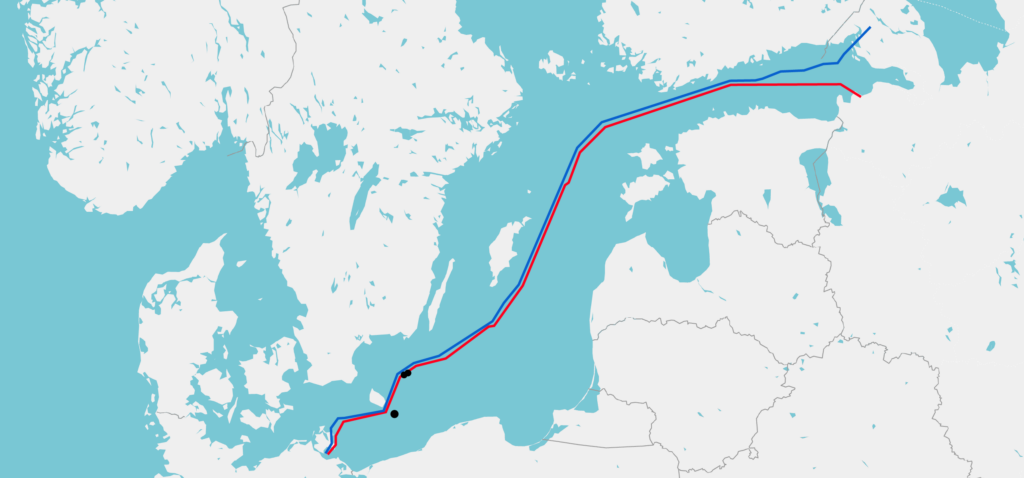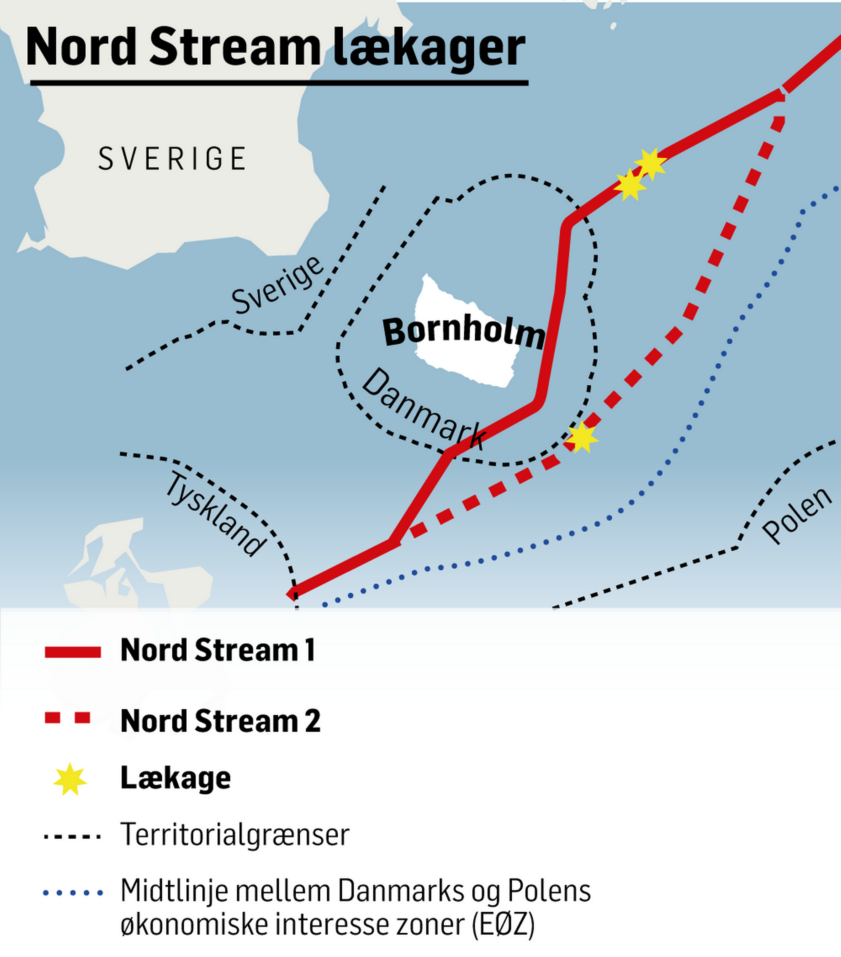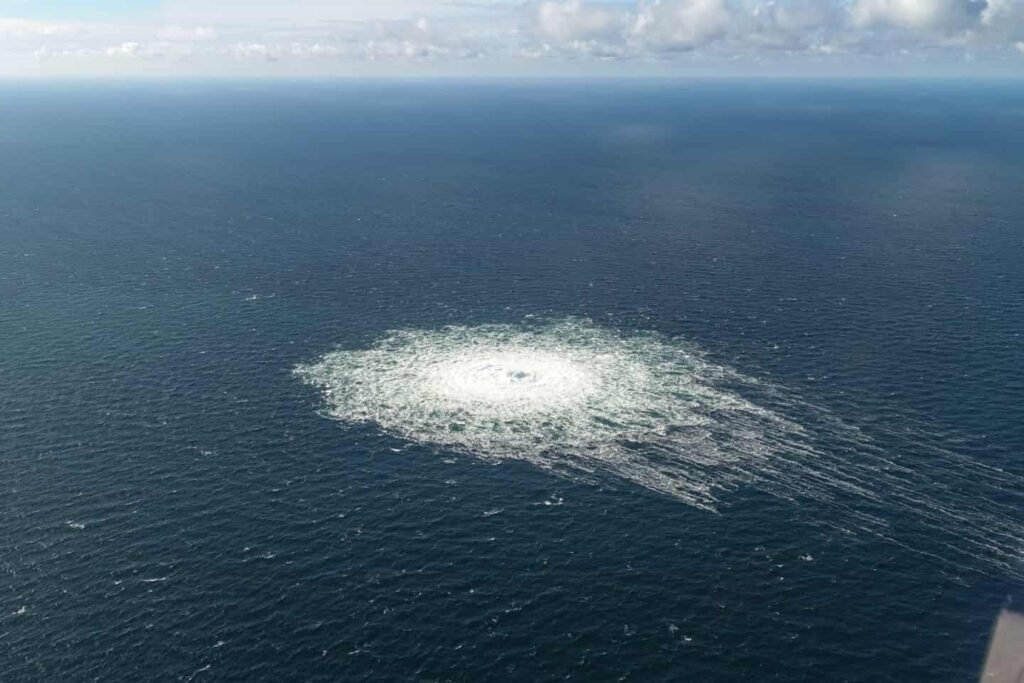
On Monday 26 September, Danish Maritime Authorities reported three gas leaks in pipelines North Stream 2 and North Stream 1 in the Baltic Sea.
The initial leak was detected on the North Stream 2 pipeline located Southeast of Dueodde on Bornholm, Denmark’s Easternmost Island. German authorities noticed a significant decrease in pressure while, simultaneously, a large area of water surface bubbles above the leaking gas pipeline was reported by Danish F16’s. Later on Monday evening, two additional leakages was reported by Swedish Sjöfartsverket on North Stream 1 located Northeast of Bornholm. One of the leakages happened within international waters although recognized as the Danish Exclusive Economic Zone (EEZ). An economic zone is a zone located outside a country’s territorial waters in which the neighboring coastal state has exclusive power of exploiting natural resources.
North Stream 1 is currently closed – officially due to maintenance – while North Stream 2 was never put operating as sanctions against Russia was initiated after the invasion of Ukraine. Reported by the Danish Ministry of Energy, the leakages have no effect on gas supplies to Denmark or the rest of Europe.

However, the leakages have raised increasing suspicions as they took place on the day of the opening of another important gas pipeline from Norway to Poland – the Baltic Pipe – which purpose is to generate less European dependency of Russian gas.
According to Danish news media DR, Swedish seismologist, Björn Lund of SNSN, an entity monitoring the Swedish underground, says the leakages happened due to an explosion corresponding 2,3 on the Richter magnitude scale, which leaves him in no doubt that several explosions took place. This was backed by Danish GEUS, Geological Survey of Denmark and Greenland, reporting seismic waves Sunday night while saying they did not resemble waves from an earthquake. Professor in geophysics at Niels Bohr Institute at University of Copenhagen, Klaus Moesgaard, says the seismic waves resembles shakings from a World War 2 bomb, and that seismologists are able to easily tell the difference of explosions and seismic waves from earthquakes.
On a doorstep-press conference Tuesday evening, Danish prime minister, Mette Frederiksen, said that “it is the Danish authoritie’s clear assessment that this is a deliberate act – not an accident”, but rejected to further comment on who might be behind. Correspondingly, Swedish prime minister, Magdalena Andersson said it was presumably sabotage.
Military researcher at Royal Danish Defence College, Søren Nørby, acknowledged the possibility of Russia sending Denmark a message of halting Ukrainian support, and suggested the explosions to be undertaken by drones or divers placing explosives by the pipelines either recently or several years ago.
“Denmark is in a difficult situation if the sea, and the infrastructure placed within, are to be surveilled (…) Surveillance is pretty terrible. It is simple to hide at sea, and one can easily perform such an operation without being spotted (…) There are offshore wind turbines, internet cables and communication cables one might imagine to be targeted.”

As of now, the area of the leakages is being surveilled by Danish Armed Forces and other authorities, while a ban of seafaring within ten kilometers of the leakages, due to danger of explosion and potential lost buoyance force if sailing above leaking gas, has been introduced. Further, flight traffic within 1 kilometer of the uprising gas is now prohibited. The general level of Military Readiness has been increased to the next highest level – orange – meaning all energy companies ought to increase security levels on energy plants and restrict access as much as possible.
The pipelines are 1.224 kilometers long and consists of 199.755 pieces of pipe of up to 12 m.. Each standard piece of pipe weighs 24 t. and has an inner diameter of 1,15 m.. Overall, 2.424.00 t. steel has been utilized for building the North Stream which has a capacity of 55 mia. m3 of gas, enough to sustain 26 mio. households equivalent to 600 shipments of liquid gas.
Sources: https://politiken.dk/indland/art8997094/Nord-Stream-Det-ved-vi-om-l%C3%A6kagerne-p%C3%A5-omstridt-r%C3%B8rledning-%E2%80%93-og-det-ved-vi-ikke
https://www.dr.dk/nyheder/indland/dansk-ekspert-eksplosion-maalt-ved-bornholm-svarer-til-en-stoerre-bombe-fra-anden


